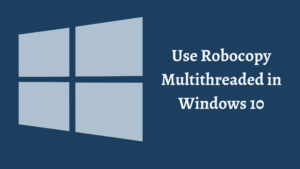
Robocopy is a command-line utility used for copying files in Windows 10. It offers several advanced features that make it popular among IT professionals and system administrators. One of its features is the ability to use multiple threads, which allows for faster file copying. In this article, we will explore how to use Robocopy multithreaded in Windows 10.
How to Use Robocopy Multithreaded in Windows 10
Below we explain How to Use Robocopy Multithreaded in Windows 10
Robocopy Commands Breakdown – Robocopy Multithreaded
Before we dive into how to use Robocopy multithreaded in Windows 10, let’s first understand the basic Robocopy commands. Here are some of the most commonly used commands:
- /S – Copies subdirectories, but not empty ones.
- /E – Copies subdirectories, including empty ones.
- /Z – Copies files in restartable mode.
- /R:n – Specifies the number of times Robocopy will retry a failed copy operation.
- /W:n – Specifies the wait time between retries in seconds.
- /MT[:n] – Specifies the number of threads to be used. The default is 8.
The /MT command is what we are interested in for this article. It specifies the number of threads that Robocopy will use for copying files. By default, Robocopy uses 8 threads, but you can increase or decrease this number depending on your needs.
To use Robocopy multithread, you need to add the /MT command to your Robocopy command line. For example, the following command will copy all files and directories from C:\Source to D:\Destination using 16 threads:
robocopy C:\Source D:\Destination /S /MT:16
The /S command copies subdirectories, but not empty ones. The /MT:16 command specifies that Robocopy should use 16 threads for copying.

Further | Robocopy Multithreaded
Using multiple threads can significantly speed up the file copying process. However, it’s important to keep in mind that using too many threads can actually slow down the process. This is because each thread requires CPU resources, and if there are too many threads running at once, they can compete for resources and slow each other down.
To find the optimal number of threads for your system, you should experiment with different values and monitor the CPU usage during the file copying process. You should also consider the type of storage devices being used. For example, copying files between two SSDs will likely require fewer threads than copying files between a hard drive and an SSD.
It’s also worth noting that using Robocopy multithread can cause issues with some antivirus software. Some antivirus programs may mistake the multiple threads as a potential threat and interfere with the file copying process. If you encounter issues with antivirus software while using Robocopy multithreaded, you may need to temporarily disable the antivirus software or adjust its settings.
Conclusion
Using Robocopy multithread is a simple way to speed up the file copying process in Windows 10. By using multiple threads, Robocopy can take advantage of the available CPU resources and copy files faster than it would with a single thread. However, it’s important to find the optimal number of threads for your system and to be aware of potential issues with antivirus software. With these considerations in mind, you can use Robocopy multithreaded to efficiently copy files in Windows 10.
Thanks for reading!